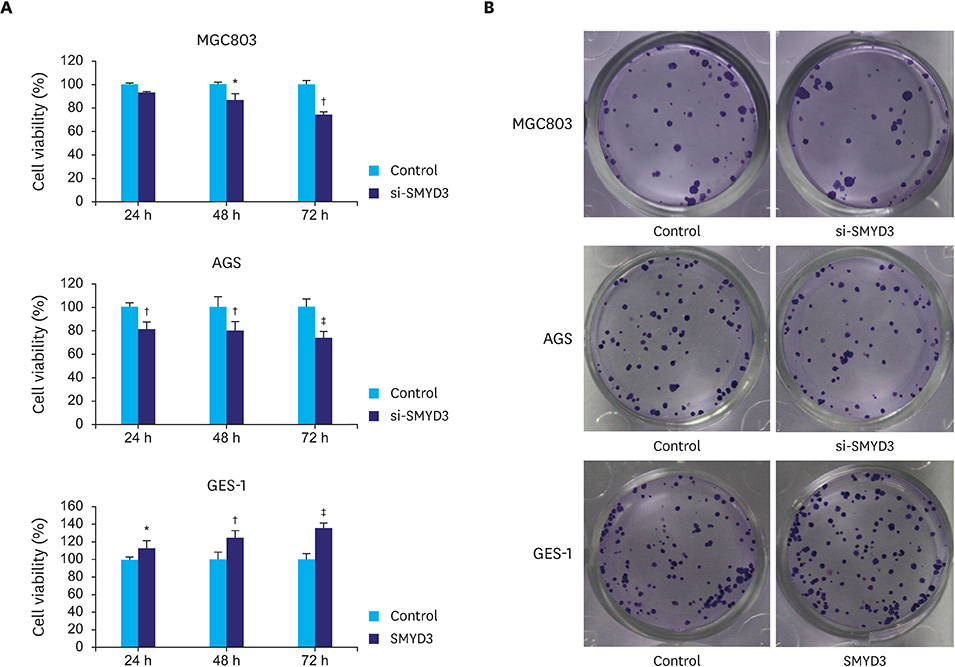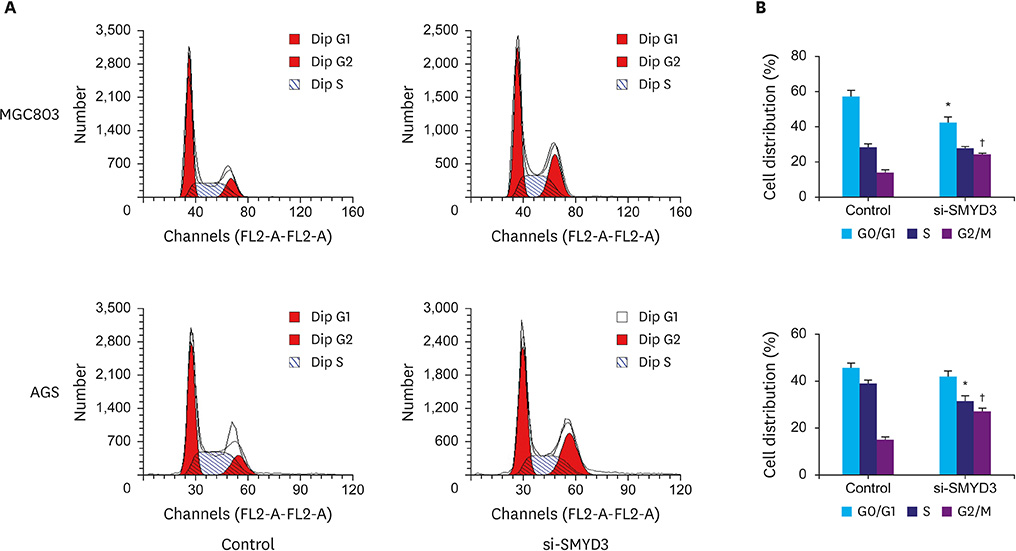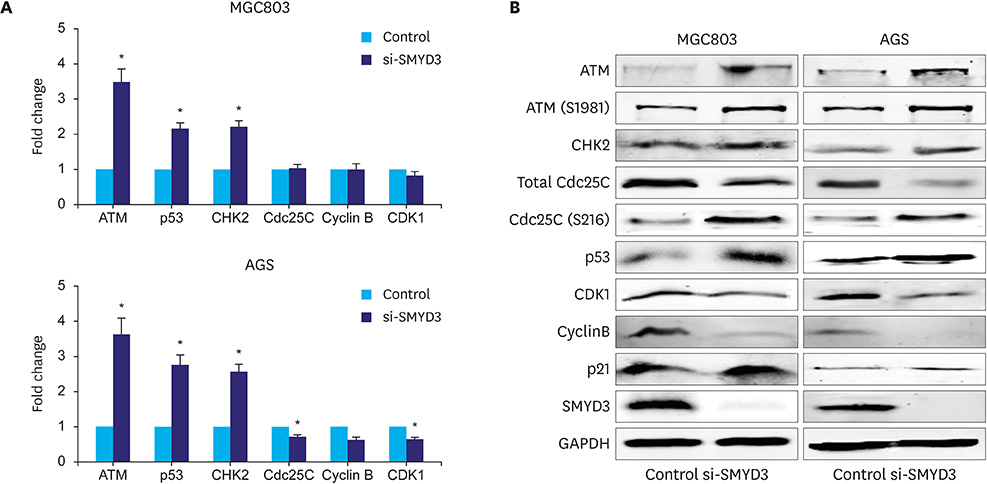J Gastric Cancer.
2017 Dec;17(4):295-305. 10.5230/jgc.2017.17.e33.
ATM Signaling Pathway Is Implicated in the SMYD3-mediated Proliferation and Migration of Gastric Cancer Cells
- Affiliations
-
- 1Key Laboratory of Industrial Fermentation Microbiology, Ministry of Education, Tianjin University of Science and Technology, Tianjin, China. luoxuegang@hotmail.com
- 2Tianjin Industrial Microbiology Key Lab, College of Biotechnology, Tianjin University of Science and Technology, Tianjin, China.
- 3Department of Gastric Cancer Surgery, Tianjin Medical University Cancer Institute and Hospital, National Clinical Research Center for Cancer, Tianjin, China.
- 4Tianjin Key Laboratory of Cancer Prevention and Therapy, National Clinical Research Center for Cancer, Tianjin, China.
- KMID: 2398796
- DOI: http://doi.org/10.5230/jgc.2017.17.e33
Abstract
- PURPOSE
We previously found that the histone methyltransferase suppressor of variegation, enhancer of zeste, trithorax and myeloid-nervy-deformed epidermal autoregulatory factor-1 domain-containing protein 3 (SMYD3) is a potential independent predictive factor or prognostic factor for overall survival in gastric cancer patients, but its roles seem to differ from those in other cancers. Therefore, in this study, the detailed functions of SMYD3 in cell proliferation and migration in gastric cancer were examined.
MATERIALS AND METHODS
SMYD3 was overexpressed or suppressed by transfection with an expression plasmid or siRNA, and a wound healing migration assay and Transwell assay were performed to detect the migration and invasion ability of gastric cancer cells. Additionally, an MTT assay and clonogenic assay were performed to evaluate cell proliferation, and a cell cycle analysis was performed by propidium iodide staining. Furthermore, the expression of genes implicated in the ataxia telangiectasia mutated (ATM) pathway and proteins involved in cell cycle regulation were detected by polymerase chain reaction and western blot analyses.
RESULTS
Compared with control cells, gastric cancer cells transfected with si-SMYD3 showed lower migration and invasion abilities (P<0.05), and the absence of SMYD3 halted cells in G2/M phase and activated the ATM pathway. Furthermore, the opposite patterns were observed when SMYD3 was elevated in normal gastric cells.
CONCLUSIONS
To the best of our knowledge, this study provides the first evidence that the absence of SMYD3 could inhibit the migration, invasion, and proliferation of gastric cancer cells and halt cells in G2/M phase via the ATM-CHK2/p53-Cdc25C pathway. These findings indicated that SMYD3 plays crucial roles in the proliferation, migration, and invasion of gastric cancer cells and may be a useful therapeutic target in human gastric carcinomas.
MeSH Terms
Figure
Reference
-
1. Nagata DE, Ting HA, Cavassani KA, Schaller MA, Mukherjee S, Ptaschinski C, et al. Epigenetic control of Foxp3 by SMYD3 H3K4 histone methyltransferase controls iTreg development and regulates pathogenic T-cell responses during pulmonary viral infection. Mucosal Immunol. 2015; 8:1131–1143.2. Foreman KW, Brown M, Park F, Emtage S, Harriss J, Das C, et al. Structural and functional profiling of the human histone methyltransferase SMYD3. PLoS One. 2011; 6:e22290.3. Vieira FQ, Costa-Pinheiro P, Almeida-Rios D, Graça I, Monteiro-Reis S, Simões-Sousa S, et al. SMYD3 contributes to a more aggressive phenotype of prostate cancer and targets Cyclin D2 through H4K20me3. Oncotarget. 2015; 6:13644–13657.4. Hamamoto R, Furukawa Y, Morita M, Iimura Y, Silva FP, Li M, et al. SMYD3 encodes a histone methyltransferase involved in the proliferation of cancer cells. Nat Cell Biol. 2004; 6:731–740.5. Wang SZ, Luo XG, Shen J, Zou JN, Lu YH, Xi T. Knockdown of SMYD3 by RNA interference inhibits cervical carcinoma cell growth and invasion in vitro. BMB Rep. 2008; 41:294–299.6. Luo XG, Zhang CL, Zhao WW, Liu ZP, Liu L, Mu A, et al. Histone methyltransferase SMYD3 promotes MRTF-A-mediated transactivation of MYL9 and migration of MCF-7 breast cancer cells. Cancer Lett. 2014; 344:129–137.7. Hamamoto R, Silva FP, Tsuge M, Nishidate T, Katagiri T, Nakamura Y, et al. Enhanced SMYD3 expression is essential for the growth of breast cancer cells. Cancer Sci. 2006; 97:113–118.8. Van Aller GS, Reynoird N, Barbash O, Huddleston M, Liu S, Zmoos AF, et al. Smyd3 regulates cancer cell phenotypes and catalyzes histone H4 lysine 5 methylation. Epigenetics. 2012; 7:340–343.9. Liu Y, Luo X, Deng J, Pan Y, Zhang L, Liang H. SMYD3 overexpression was a risk factor in the biological behavior and prognosis of gastric carcinoma. Tumour Biol. 2015; 36:2685–2694.10. Deng LJ, Peng QL, Wang LH, Xu J, Liu JS, Li YJ, et al. Arenobufagin intercalates with DNA leading to G2 cell cycle arrest via ATM/ATR pathway. Oncotarget. 2015; 6:34258–34275.11. Fu W, Liu N, Qiao Q, Wang M, Min J, Zhu B, et al. Structural basis for substrate preference of SMYD3, a SET domain-containing protein lysine methyltransferase. J Biol Chem. 2016; 291:9173–9180.12. Ren TN, Wang JS, He YM, Xu CL, Wang SZ, Xi T. Effects of SMYD3 over-expression on cell cycle acceleration and cell proliferation in MDA-MB-231 human breast cancer cells. Med Oncol. 2011; 28:Suppl 1. S91–S98.13. Shibata A, Barton O, Noon AT, Dahm K, Deckbar D, Goodarzi AA, et al. Role of ATM and the damage response mediator proteins 53BP1 and MDC1 in the maintenance of G(2)/M checkpoint arrest. Mol Cell Biol. 2010; 30:3371–3383.14. Nilsson I, Hoffmann I. Cell cycle regulation by the Cdc25 phosphatase family. Prog Cell Cycle Res. 2000; 4:107–114.15. Sun H, Wang Y, Wang Z, Meng J, Qi Z, Yang G. Aurora-A controls cancer cell radio- and chemoresistance via ATM/Chk2-mediated DNA repair networks. Biochim Biophys Acta. 2014; 1843:934–944.16. Knappskog S, Chrisanthar R, Løkkevik E, Anker G, Østenstad B, Lundgren S, et al. Low expression levels of ATM may substitute for CHEK2/TP53 mutations predicting resistance towards anthracycline and mitomycin chemotherapy in breast cancer. Breast Cancer Res. 2012; 14:R47.17. Meier M, den Boer ML, Hall AG, Irving JA, Passier M, Minto L, et al. Relation between genetic variants of the ataxia telangiectasia-mutated (ATM) gene, drug resistance, clinical outcome and predisposition to childhood T-lineage acute lymphoblastic leukaemia. Leukemia. 2005; 19:1887–1895.18. Zhou Y, Wan G, Spizzo R, Ivan C, Mathur R, Hu X, et al. miR-203 induces oxaliplatin resistance in colorectal cancer cells by negatively regulating ATM kinase. Mol Oncol. 2014; 8:83–92.19. Sun W, Tang L. MDM2 increases drug resistance in cancer cells by inducing EMT independent of p53. Curr Med Chem. 2016; 23:4529–4539.20. Mutlu M, Raza U, Saatci Ö, Eyüpoğlu E, Yurdusev E, Şahin Ö. miR-200c: a versatile watchdog in cancer progression, EMT, and drug resistance. J Mol Med (Berl). 2016; 94:629–644.21. Du B, Shim JS. Targeting epithelial-mesenchymal transition (EMT) to overcome drug resistance in cancer. Molecules. 2016; 21:E965.22. Liu G, Liu YJ, Lian WJ, Zhao ZW, Yi T, Zhou HY. Reduced BMP6 expression by DNA methylation contributes to EMT and drug resistance in breast cancer cells. Oncol Rep. 2014; 32:581–588.23. Mitra A, Mishra L, Li S. EMT, CTCs and CSCs in tumor relapse and drug-resistance. Oncotarget. 2015; 6:10697–10711.24. Brown WS, Akhand SS, Wendt MK. FGFR signaling maintains a drug persistent cell population following epithelial-mesenchymal transition. Oncotarget. 2016; 7:83424–83436.25. Sarris ME, Moulos P, Haroniti A, Giakountis A, Talianidis I. Smyd3 is a transcriptional potentiator of multiple cancer-promoting genes and required for liver and colon cancer development. Cancer Cell. 2016; 29:354–366.
- Full Text Links
- Actions
-
Cited
- CITED
-
- Close
- Share
- Similar articles
-
- LETM1 Promotes Gastric Cancer Cell Proliferation, Migration, and Invasion via the PI3K/Akt Signaling Pathway
- Activation of ATM-dependent DNA Damage Signal Pathway by a Histone Deacetylase Inhibitor, Trichostatin A
- Vitexin Inhibits Gastric Cancer Growth and Metastasis through HMGB1-mediated Inactivation of the PI3K/ AKT/mTOR/HIF-1α Signaling Pathway
- Alisol A Inhibited the Proliferation, Migration, and Invasion of Nasopharyngeal Carcinoma Cells by Inhibiting the Hippo Signaling Pathway
- Apoptotic Pathway Induced by Dominant Negative ATM Gene in CT-26 Colon Cancer Cells





